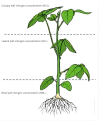Monitoring of Nitrogen Concentration in Soybean Leaves at Multiple Spatial Vertical Scales Based on Spectral Parameters
- PMID: 38202447
- PMCID: PMC10780363
- DOI: 10.3390/plants13010140
Monitoring of Nitrogen Concentration in Soybean Leaves at Multiple Spatial Vertical Scales Based on Spectral Parameters
Abstract
Nitrogen is a fundamental component for building amino acids and proteins, playing a crucial role in the growth and development of plants. Leaf nitrogen concentration (LNC) serves as a key indicator for assessing plant growth and development. Monitoring LNC provides insights into the absorption and utilization of nitrogen from the soil, offering valuable information for rational nutrient management. This, in turn, contributes to optimizing nutrient supply, enhancing crop yields, and minimizing adverse environmental impacts. Efficient and non-destructive estimation of crop LNC is of paramount importance for on-field crop management. Spectral technology, with its advantages of repeatability and high-throughput observations, provides a feasible method for obtaining LNC data. This study explores the responsiveness of spectral parameters to soybean LNC at different vertical scales, aiming to refine nitrogen management in soybeans. This research collected hyperspectral reflectance data and LNC data from different leaf layers of soybeans. Three types of spectral parameters, nitrogen-sensitive empirical spectral indices, randomly combined dual-band spectral indices, and "three-edge" parameters, were calculated. Four optimal spectral index selection strategies were constructed based on the correlation coefficients between the spectral parameters and LNC for each leaf layer. These strategies included empirical spectral index combinations (Combination 1), randomly combined dual-band spectral index combinations (Combination 2), "three-edge" parameter combinations (Combination 3), and a mixed combination (Combination 4). Subsequently, these four combinations were used as input variables to build LNC estimation models for soybeans at different vertical scales using partial least squares regression (PLSR), random forest (RF), and a backpropagation neural network (BPNN). The results demonstrated that the correlation coefficients between the LNC and spectral parameters reached the highest values in the upper soybean leaves, with most parameters showing significant correlations with the LNC (p < 0.05). Notably, the reciprocal difference index (VI6) exhibited the highest correlation with the upper-layer LNC at 0.732, with a wavelength combination of 841 nm and 842 nm. In constructing the LNC estimation models for soybeans at different leaf layers, the accuracy of the models gradually improved with the increasing height of the soybean plants. The upper layer exhibited the best estimation performance, with a validation set coefficient of determination (R2) that was higher by 9.9% to 16.0% compared to other layers. RF demonstrated the highest accuracy in estimating the upper-layer LNC, with a validation set R2 higher by 6.2% to 8.8% compared to other models. The RMSE was lower by 2.1% to 7.0%, and the MRE was lower by 4.7% to 5.6% compared to other models. Among different input combinations, Combination 4 achieved the highest accuracy, with a validation set R2 higher by 2.3% to 13.7%. In conclusion, by employing Combination 4 as the input, the RF model achieved the optimal estimation results for the upper-layer LNC, with a validation set R2 of 0.856, RMSE of 0.551, and MRE of 10.405%. The findings of this study provide technical support for remote sensing monitoring of soybean LNCs at different spatial scales.
Keywords: hyperspectral; leaf nitrogen content; remote sensing; soybean; spectral parameters.
Conflict of interest statement
The authors declare no conflicts of interest.
Figures







Similar articles
-
Inversion of Nitrogen Concentration in Apple Canopy Based on UAV Hyperspectral Images.Sensors (Basel). 2022 May 4;22(9):3503. doi: 10.3390/s22093503. Sensors (Basel). 2022. PMID: 35591193 Free PMC article.
-
Off-Nadir Hyperspectral Sensing for Estimation of Vertical Profile of Leaf Chlorophyll Content within Wheat Canopies.Sensors (Basel). 2017 Nov 23;17(12):2711. doi: 10.3390/s17122711. Sensors (Basel). 2017. PMID: 29168757 Free PMC article.
-
Assessing different regression algorithms for paddy rice leaf nitrogen concentration estimations from the first-derivative fluorescence spectrum.Opt Express. 2020 Jun 22;28(13):18728-18741. doi: 10.1364/OE.395478. Opt Express. 2020. PMID: 32672167
-
Inversion of nitrogen and phosphorus contents in cotton leaves based on the Gaussian mixture model and differences in hyperspectral features of UAV.Spectrochim Acta A Mol Biomol Spectrosc. 2025 Feb 15;327:125419. doi: 10.1016/j.saa.2024.125419. Epub 2024 Nov 10. Spectrochim Acta A Mol Biomol Spectrosc. 2025. PMID: 39547149 Review.
-
Nitrogen monitoring and inversion algorithms of fruit trees based on spectral remote sensing: a deep review.Front Plant Sci. 2024 Nov 22;15:1489151. doi: 10.3389/fpls.2024.1489151. eCollection 2024. Front Plant Sci. 2024. PMID: 39687315 Free PMC article. Review.
Cited by
-
Introduction to the Special Issue of Plants on "The Application of Spectral Techniques in Agriculture and Forestry".Plants (Basel). 2024 Sep 20;13(18):2632. doi: 10.3390/plants13182632. Plants (Basel). 2024. PMID: 39339603 Free PMC article.
-
Indirect Estimation of Heavy Metal Contamination in Rice Soil Using Spectral Techniques.Plants (Basel). 2024 Mar 14;13(6):831. doi: 10.3390/plants13060831. Plants (Basel). 2024. PMID: 38592865 Free PMC article.
References
-
- Guo S., Zhang Z., Guo E., Fu Z., Gong J., Yang X. Historical and projected impacts of climate change and technology on soybean yield in China. Agric. Syst. 2022;203:103522. doi: 10.1016/j.agsy.2022.103522. - DOI
-
- Sun Y., Chen X., Shan J., Xian J., Cao D., Luo Y., Yao R., Zhang X. Nitrogen mitigates salt stress and promotes wheat growth in the Yellow River Delta, China. Water. 2022;14:3819. doi: 10.3390/w14233819. - DOI
-
- Sharma S.K., Sharma P.K., Mandeewal R.L., Sharma V., Chaudhary R., Pandey R., Gupta S. Effect of foliar application of nano-urea under different nitrogen levels on growth and nutrient content of pearl millet (Pennisetum glaucum L.) Int. J. Plant Sci. 2022;34:149–155. doi: 10.9734/ijpss/2022/v34i2031138. - DOI
-
- Olveira A.L., Rozas H.S., CastroFranco M., Carciochi W., Nieto L., Balzarini M., Ciampitti I., Reussi Calvo N. Monitoring corn nitrogen concentration from radar (C-SAR), optical, and sensor satellite data fusion. Remote Sens. 2023;15:824. doi: 10.3390/rs15030824. - DOI
Grants and funding
LinkOut - more resources
Full Text Sources

